Enhancing Overseas Japanese-Language Teaching Methods and Proficiency Assessments of Japanese-Language Learners
To promote the Japanese language, the Japan Foundation provided new teaching methods and learning materials and implemented the Japanese-Language Proficiency Test (JLPT) and the Japan Foundation Test for Basic Japanese (JFT-Basic) for Japanese-language learners, as well as conducted research related to Japanese-language education.
Disseminating Information about Japanese-Language Teaching Methods and Providing Learning Materials
The JF Standard for Japanese-Language Education is a framework developed by the Japan Foundation for considering ways to learn and teach the Japanese language and make evaluations based on the concept of the Common European Framework of Reference for Languages (CEFR). For Marugoto: Japanese Language and Culture, a teaching material based on the JF Standard, we expanded the coursebook levels published in China and provided supplementary materials in multiple languages on the Marugoto website.
Similarly, we introduced multilingual support and content expansion for Irodori: Japanese for Life in Japan and for Hikidasu Nihongo: Activate Your Japanese Content-Library website, which are also teaching materials based on the JF Standard.
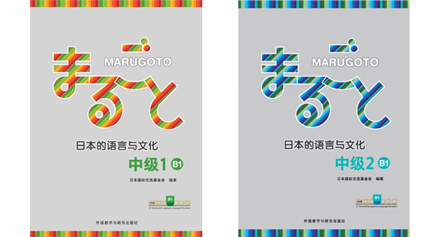
Intermediate 1 and 2 courses of Marugoto:
Japanese Language and Culture (China version)
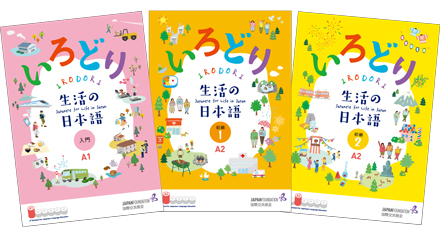
Starter, elementary 1, and elementary 2 courses of Irodori:
Japanese for Life in Japan
Nihongo Kyoiku Tsushin provides news and classroom ideas about Japanese-language education, primarily for Japanese-language teachers in Japan and overseas. In FY2023, we published 15 articles.
The Japan Foundation Journal on Japanese-language Education publishes articles and reports on educational practices and teaching material development written by domestic and international experts involved in the Japan Foundation’s Japanese-language education projects. In FY2023, we published Vol. 20 as an electronic journal, featuring 2 articles and 6 reports.
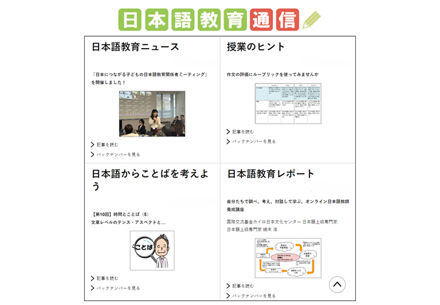
Providing various information about Japanese-language education through Nihongo Kyoiku Tsushin on the JF website
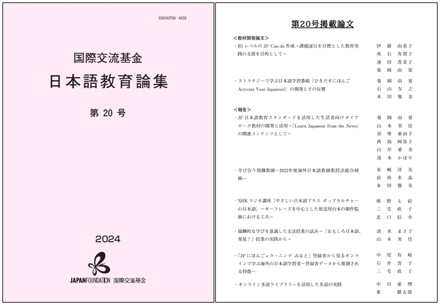
This fiscal year’s journal featured articles on JF-developed Japanese-language teaching materials and various practice reports
Development and Operation of e-Learning
The number of annual participants of the Japanese-language learning platform JF Japanese e-Learning Minato reached approximately 158,000 people in 189 countries and regions, and the total number of registered users reached approximately 430,000 people in 203 countries and regions.
In response to the increasing establishment of self-study through online courses as a means of Japanese-language learning overseas, we met diverse learning needs through initiatives such as launching the Home Visit Course, which enables virtual visits to Japanese homes using 360-degree videos and still images.
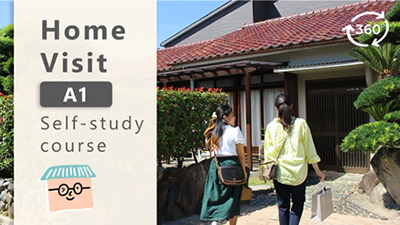
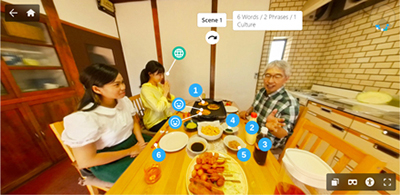
Home Visit A1 Self-Study Course using 360-degree videos and still images
Implementing Tests to Evaluate Japanese-Language Proficiency
Launched in 1984, the Japanese-Language Proficiency Test (JLPT) is the world’s largest-scale test measuring the Japanese-language skills of non-native speakers.
With COVID-19 restrictions easing in 2023, there was a record-high total of approximately 1.48 million applicants both within and outside Japan, with overseas applications exceeding 1 million for the first time.
For the July test, approximately 484,000 people applied for the exam in 168 cities in 54 countries around the world and approximately 405,000 took it.
For the December test, Cirebon (Indonesia), Darkhan (Mongolia), and Santa Fe (Argentina) were included for the first time, with approximately 525,000 applicants from 247 cities in 84 countries and approximately 427,000 test-takers.
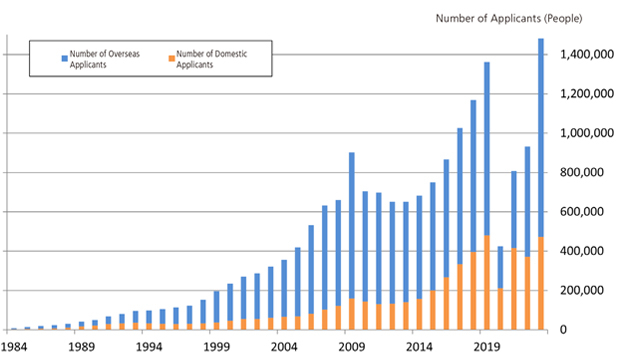
Changes in Number of JLPT Applicants (1984–2023)
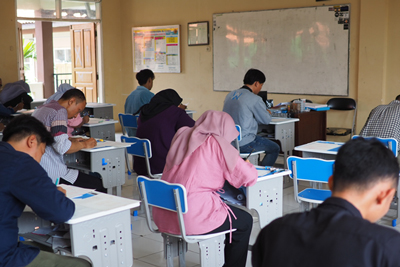
JLPT is being newly implemented in Cirebon, Indonesia from FY2023
Commenced in 2019, the Japan Foundation Test for Basic Japanese (JFT-Basic) is a computer-based test to measure the Japanese-language proficiency needed by foreign nationals about to reside in Japan mainly for work, to communicate in everyday life situations.
In FY2023, new test sites were established in Denpasar, Indonesia, and Bengaluru, India. Approximately 103,000 people took the test (up from approximately 47,000 in the previous fiscal year) across 21 cities in 11 countries, primarily in Asia, as well as within Japan.
Japanese-Language Education Programs for Acceptance of Foreign Human Resources
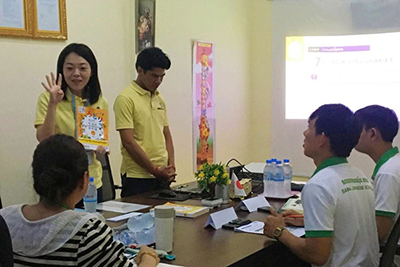
A Japanese for Life in Japan Coordinator explains how to use Irodori during an institutional visit
The Japan Foundation promoted initiatives in 15 countries, mainly in Asia, to support the acquisition of Japanese-language proficiency by people aiming to live and work in Japan. We added one language to the web-based Japanese-language teaching material Irodori: Japanese for Life in Japan for a total of 17 languages, and the material was accessed approximately 4.38 million times this fiscal year. Meanwhile, for the Irodori Japanese Online Course, which was developed based on the same materials, we newly released eight language versions of the starter (A1) course. In various countries, Japanese-Language Specialists and Japanese for Life in Japan Coordinators introduced Irodori and held seminars on how to teach using this coursebook.
Inviting Ain Shams University Representatives
The Japan Foundation invited two representatives from Ain Shams University in Egypt—the Dean of the Faculty of Languages, who also heads the Japanese Department, and a full-time lecturer from the Japanese Department—to visit Japan for 10 days. The university houses one of Egypt’s leading Japanese departments alongside Cairo University. Through visits to the JF Headquarters and various universities, we provided networking opportunities to strengthen their department and graduate school operations while deepening the Dean’s understanding of Japan during her first visit to the country.
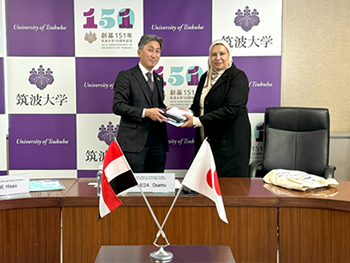
Visiting the University of Tsukuba
Support for Japanese-Language Education Institutions in Ukraine
The Japan Foundation donated Japanese-language books, teaching materials, and cultural items to eight institutions in Ukraine that continue to provide Japanese-language education despite the ongoing war. In addition to resuming the JLPT, we developed an online learning and exchange platform. A Japanese-language specialist conducted online Japanese courses and teacher training. We received grateful feedback from participants, with some noting that “studying Japanese helps us forget about the war for a while.”
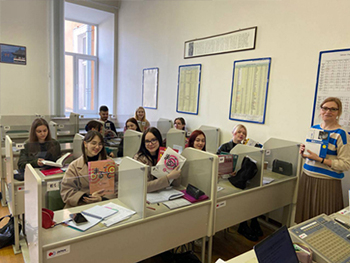
A Japanese-language class at National University of Kyiv
- About Us Top
- About the Japan Foundation
- Donations
- News & Topics
- News & Topics Top
- Main Activities
- Main Activities Top
- Fiscal Year 2025-2026
- Fiscal Year 2024-2025
- Fiscal Year 2023-2024
- Fiscal Year 2022-2023
- Fiscal Year 2021-2022
- Fiscal Year 2020-2021
- Fiscal Year 2019-2020
- Fiscal Year 2018-2019
- Fiscal Year 2017-2018
- Fiscal Year 2016-2017
- Fiscal Year 2015-2016
- Fiscal Year 2014-2015
- Fiscal Year 2013-2014
- Events / Projects
- Press Release
- Press Release Top
- Fiscal Year 2025-2026
- Fiscal Year 2024-2025
- Fiscal Year 2023-2024
- Fiscal Year 2022-2023
- Fiscal Year 2021-2022
- Fiscal Year 2020-2021
- Fiscal Year 2019-2020
- Fiscal Year 2018-2019
- Fiscal Year 2017-2018
- Fiscal Year 2016-2017
- Fiscal Year 2015-2016
- Fiscal Year 2014-2015
- Fiscal Year 2013-2014
- Links
